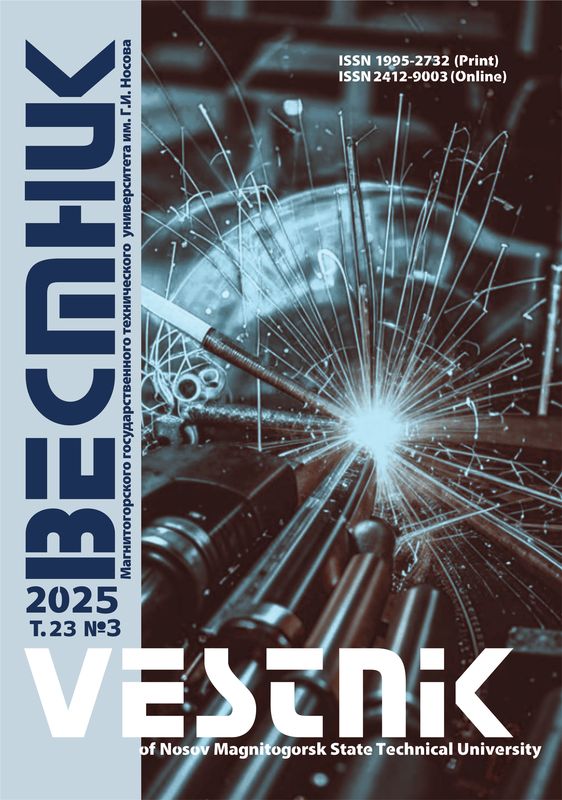DOI: 10.18503/1995-2732-2023-21-1-93-99
Abstract
Modern development of machines demands increased hardness and reliability of materials and structures. Usually, this is done by introducing new chemical compositions of materials and new methods of material treatment. Following the computer finite element modeling, this paper demonstrates another efficient method of increasing hardness and reliability of materials and structures by selecting the reasonable geometry of structure elements and conditions of their interactions. These geometrical structures, first introduced by mathematicians, are called interlocking. An interlocking structure is a set of convex bodies arranged so that any infinitely small movement of one of them is possible only as a part of a simultaneous movement by all bodies (as if they were a single body). Modeling was carried out in the Abaqus software complex to demonstrate a conceptual approach to the use of interlocking structures in the development of structural materials for various purposes. Using the simulation results, the authors have studied various patterns of load distribution in such systems and put forward theories about their application in future studies. It was found that depending on various loading scenarios, such structures can dispel the applied point loads along the entire volume of the structural element. The paper also demonstrates the potential for optimizing the geometry of individual elements of interlocking structures, contributing to expanding their operational properties, while maintaining key features. The authors provide a scientific rationale for applying such structures in future to redistribute loads both in structural materials and in a wide range of tools.
Keywords
interlocking structures, hardness, operational reliability, new materials, structures, finite element modeling, stress redistribution
For citation
Konstantinov D.V., Matveev S.V., Pesin A.M., Korchunov A.G., Pivovarova K.G. Application of Interlocking Structures: FEM-Based Concept Demonstration. Vestnik Magnitogorskogo Gosudarstvennogo Tekhnicheskogo Universiteta im. G.I. Nosova [Vestnik of Nosov Magnitogorsk State Technical University]. 2023, vol. 21, no. 1, pp. 93-99. https://doi.org/10.18503/1995-2732-2023-21-1-93-99
1. Dyskin A.V., Estrin Y., Kanel-Belov A.J., Pasternak E. Toughening by fragmentation – how topology helps. Advanced Engineering Mater. 2001;3:885-888.
2. Dyskin A.V., Estrin Y., Kanel-Belov A.J., Pasternak E. Topological interlocking of platonic solids: A way to new materials and structures. Phil. Mag. Lett. 2003;83:197-203.
3. Dyskin A.V., Estrin Y., Pasternak E., Khor H.C., Kanel-Belov A.J. Fracture resistant structures based on topological interlocking with nonplanar contacts. Advanced Engineering Mater. 2003;5(3):116-119.
4. Kanel-Belov A.J. Interlocking structures. Kvant. Fiziko-matematicheskii zhurnal dlya shkolnikov i studentov [Quantum. Journal of Physics and Mathematics for School and University Students]. 2009;1:20-23. (In Russ.)
5. Dyskin A.V., Estrin Y., Pasternak E., Khor H.C., Kanel-Belov A.J. The principle of topological inter-locking in extraterrestrial construction. Acta Astronautica. 2005;57(1):10-21.
6. Estrin Y., Dyskin A.V., Pasternak E., Khor H.C., Kanel-Belov A.J. Topological interlocking of protective tiles for Space Shuttle. Phil. Mag. Letters. 2003;83:351-355.
7. Dyskin A.V., Estrin Y., Kanel-Belov A.J., Pasternak E. Interlocking properties of buckyballs. Physics Letters A. 2003;319:373-378.
8. Djumas L., Simon G.P., Estrin Y. et al. Deformation mechanics of non-planar topologically interlocked assemblies with structural hierarchy and varying geometry. Scientific Reports. 2017;7(1):11844. https://doi.org/10.1038/s41598-017-12147-3
9. Krishan A.L., Pesin A.M., Belov A.Ya., Pasternak E., Lokotunina N.M., Sagadatov A.I. A butt joint of the reinforced concrete floor and the column. RU2021126274 (Application) 2021.
10. Pesin A.M., Belov A.Ya., Diskin A.V., Tulupov O.N., Pustovoytov D.O., Lokotunina N.M., Biryukova O.D. Method of producing the bimetallic layered steel-aluminum alloy composites. RU2756086 (Patent) 2021.
11. Pesin A.M., Belov A.Ya., Pasternak E., Belov V.K., Pustovoytov D.O., Lokotunina N.M., Biryukova O.D., Kozhemyakina A.E. Method of producing layered rolled products. RU2021101410 (Application for an invention) 2021.
12. Pesin A.M., Kharitonov V.A., Belov A.Ya., Pasternak E., Tulupov O.N., Pustovoytov D.O., Lokotunina N.M. Method of producing bimetallic wire. RU2021106748 (Application for an invention) 2021.
13. Pesin A.M., Kharitonov V.A., Tulupov O.N., Belov A.Ya., Diskin A.V., Pustovoytov D.O., Lokotunina N.M. Drawing die. RU2021110188 (Application for an invention) 2021.
14. Pesin A.M., Kharitonov V.A., Korchunov A.G., Belov A.Ya., Pasternak E., Pustovoytov D.O., Pivovarova K.G. Split die. RU2021110189 (Application for an invention) 2021.
15. Pesin A.M., Kharitonov V.A., Belov A.Ya., Diskin A.V., Baryshnikov M.P., Pustovoytov D.O., Izvekov Yu.A., Nosov L.V., Pesin I.A. Roller die. RU2021113061 (Application for an invention) 2021.












